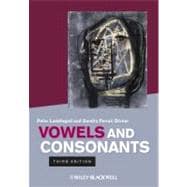
Note: Supplemental materials are not guaranteed with Rental or Used book purchases.
Purchase Benefits
What is included with this book?
Sandra Ferrari Disner teaches general and forensic linguistics at the University of Southern California. She has over 25 years of experience in speech technology, having developed commercial text-to-speech and speech-recognition systems in five languages, as well as the world's first talking video games.
Author’s Preface from the First Edition xiii
Preface to the Third Edition xiv
Acknowledgments from the Previous Editions xvi
The International Phonetic Alphabet xviii
1 Sounds and Languages 1
1.1 Languages Come and Go 1
1.2 The Evolving Sounds of Languages 4
1.3 Language and Speech 5
1.4 Describing Speech Sounds 6
1.5 Summary 9
2 Pitch and Loudness 11
2.1 Tones 11
2.2 English Intonation 14
2.3 The Vocal Folds 20
2.4 Loudness Differences 23
2.5 Summary 24
3 Vowel Contrasts 26
3.1 Sets of Vowels and Standard Forms of a Language 26
3.2 English Vowels 28
3.3 Summary 31
4 The Sounds of Vowels 32
4.1 Acoustic Structure of Vowels 32
4.2 The Acoustic Vowel Space 35
4.3 Spectrographic Displays 37
4.4 Summary 38
5 Charting Vowels 39
5.1 Formants One and Two 39
5.2 Accents of English 43
5.3 Formant Three 46
5.4 Summary 47
6 The Sounds of Consonants 48
6.1 Consonant Contrasts 48
6.2 Stop Consonants 48
6.3 Approximants 53
6.4 Nasals 54
6.5 Fricatives 55
6.6 Summary 60
7 Acoustic Components of Speech 62
7.1 The Principal Acoustic Components 62
7.2 Synthesizing Speech 64
7.3 Summary 67
8 Talking Computers 68
8.1 Words in Context 68
8.2 Our Implicit Knowledge 72
8.3 Synthesizing Sounds from a Phonetic Transcription 75
8.4 Applications 78
8.5 Summary 81
9 Listening Computers 82
9.1 Patterns of Sound 82
9.2 The Basis of Computer Speech Recognition 87
9.3 Special Context Speech Recognizers 89
9.4 Recognizing Running Speech 90
9.5 Different Accents and Different Voices 94
9.6 More for the Computationally Curious 96
9.7 Summary 97
10 How We Listen to Speech 99
10.1 Confusable Sounds 99
10.2 Sound Prototypes 103
10.3 Tackling the Problem 107
10.4 Finding Words 109
10.5 Social Interactions 110
10.6 Summary 112
10.7 Further Reading and Sources 112
11 Making English Consonants 114
11.1 Acoustics and Articulation 114
11.2 The Vocal Organs 115
11.3 Places and Manners of Articulation 117
11.4 Describing Consonants 119
11.5 Summary 122
12 Making English Vowels 123
12.1 Movements of the Tongue and Lips for Vowels 123
12.2 Muscles Controlling the Tongue and Lips 126
12.3 Traditional Descriptions of Vowels 129
12.4 Summary 134
13 Actions of the Larynx 135
13.1 The Larynx 135
13.2 Voiced and Voiceless Sounds 137
13.3 Voicing and Aspiration 138
13.4 Glottal Stops 140
13.5 Breathy Voice 141
13.6 Creaky Voice 145
13.7 Further Differences in Vocal Fold Vibrations 148
13.8 Ejectives 149
13.9 Implosives 151
13.10 Recording Data from the Larynx 152
13.11 Summary 155
14 Consonants Around the World 156
14.1 Phonetic Fieldwork 156
14.2 Well-Known Consonants 158
14.3 More Places of Articulation 159
14.4 More Manners of Articulation 167
14.5 Clicks 172
14.6 Summary 175
15 Vowels Around the World 176
15.1 Types of Vowels 176
15.2 Lip Rounding 178
15.3 Nasalized Vowels 182
15.4 Voice Quality 184
15.5 Summary 185
16 Putting Vowels and Consonants Together 186
16.1 The Speed of Speech 186
16.2 Slips of the Tongue 188
16.3 The Alphabet 188
16.4 The International Phonetic Alphabet 192
16.5 Contrasting Sounds 193
16.6 Features that Matter within a Language 195
16.7 Summary 199
Glossary 200
Further Reading 205
Index 206
The New copy of this book will include any supplemental materials advertised. Please check the title of the book to determine if it should include any access cards, study guides, lab manuals, CDs, etc.
The Used, Rental and eBook copies of this book are not guaranteed to include any supplemental materials. Typically, only the book itself is included. This is true even if the title states it includes any access cards, study guides, lab manuals, CDs, etc.